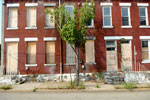
Blight-Fighting Pennsylvania Bill Targets Vacant Buildings
By Craig Smith
PITTSBURGH TRIBUNE-REVIEW
Monday, September 27, 2010

Vacant properties at 1103-1105 Fulton St. mar the Manchester section of the North Side. Philip G. Pavely/Pittsburgh Tribune-Review
Grace Rothmeyer worries about her home of 23 years in Etna, even though one of two empty houses next door finally sold.
“I’m really happy that it sold,” said Rothmeyer, 77, of Oakland Street, who waited two years for new neighbors. “Sometimes when they are empty that long, they can become crack houses.”
Empty homes and buildings are causing a dilemma for municipal officials across the nation. Pennsylvania lawmakers are working to arm local officials with tools to battle blight.
A bill before the state House would allow for extradition of out-of-state property owners with pending housing code violations. The measure, introduced by Sen. David Argall, R-Schuylkill, unanimously passed the Senate in July and awaits action in the House Urban Affairs Committee. Lawmakers hope to get it ready for the governor’s signature before the end of the year.
The extent of the problem statewide is difficult to measure, officials said. Estimates put the number of vacant buildings across Pennsylvania at 300,000, including more than 17,000 in Pittsburgh and more than 44,000 in Allegheny County.
“There is no inventory of abandoned buildings,” said attorney Irene McLaughlin, who co-chairs a task force formed by the Allegheny County Bar Association’s Real Property Section and Mayor Luke Ravenstahl’s office.
Nationwide, foreclosures rose 4.2 percent in August from July but declined 5.5 percent from a year ago. The pace of home mortgage foreclosure activity decreased 13.2 percent in the seven-county Pittsburgh region from July levels but was up 16.8 percent from August 2009, according to data from RealtyTrac Inc.
Landlords oppose Argall’s bill.
“It will hamper development; it will tie the hands of people who do that kind of work,” said Jean Yevik, president of the Western Pennsylvania Real Estate Investors Association.
She questioned whether extradition would work.
“I feel those folks have a responsibility if they bought property here, but if they are going to try to extradite those with code violations, do you think California will extradite them?” Yevik asked. “Would you like to be the test case? I would.”
Municipal authority
The bill would give municipalities the authority to go after the financial assets of negligent owners and hold lenders responsible for properties they control through foreclosure.
“That’s what we need,” said Ed Fike, mayor of Uniontown.
Once home to Sears Roebuck & Co., G.C. Murphy Co. and Kaufmann’s, the Fayette County seat is a city in transition like many Pennsylvania towns. Large, empty storefronts were converted to apartments for seniors and other uses.
Officials in small boroughs such as Etna have hoped for a broad approach rather than community-by-community enforcement.
“This needs to go up a couple levels,” borough Manager Mary Ellen Ramage said. “It is a problem that many (communities) face.”
Many of Etna’s 15 to 20 vacant buildings, including the former Freeport Hotel, have been empty for more than 10 years.
“All smaller communities are suffering the impact of this. No community is exempt,” said Diana M. Reitz, community development coordinator in Jeannette. “Government has to step it up.”
Between April 1, 2009, and March 31, Pittsburgh spent more than $615,000 in Community Development Block Grant money on clearance and demolition, according to the federal Department of Housing and Urban Development. Allegheny County spent more than $1.3 million for clearance and demolition between March 1, 2009, and Feb. 28.
Westmoreland County spent more than $303,000 between May 1, 2009, and Aug. 1 of this year for clearance and demolition, HUD records show.
Developing a plan to reuse properties after they’re acquired is critical, said Larry Larese, executive director of the Westmoreland County Industrial Development Corp.
“The devil will be in the details,” he said.
‘Right-sizing’ razing
Advocates for cities with declining populations — they call it “right-sizing” — maintain that those cities should accept they won’t rebuild population bases quickly and should level abandoned houses and buildings to make room for parks, gardens and green spaces.
The Center for Community Progress, a blight-fighting group from Flint, Mich., is working with 15 cities, including Pittsburgh, to develop strategies to deal with blight.
Flint razed 1,500 to 1,600 abandoned houses to reshape its neighborhoods, said Dan Kildee, co-founder and president of the organization and the former treasurer of Genesee County, Mich., and Genesee County Land Bank chairman.
“It’s about reuse of the land … working with local investors and neighborhoods, instead of shotgunning these properties out to the speculator market,” Kildee said.
But wholesale bulldozing worries preservationists.
“We are talking with the city about (buildings) that are architecturally valuable. And the city has been cooperative,” said Arthur Ziegler Jr., president of Pittsburgh History & Landmarks Foundation. “But there’s been no overall policy developed yet.”
People abandon buildings for many reasons, according to Sustainable Pittsburgh, an advocacy group working to revitalize urban areas.
The properties might be owned by absentee landlords or slumlords. They might be sealed, vacant properties that speculators are sitting on. Some are underwater — that is, the debt exceeds market value. Others are owned and occupied by people whose incomes don’t allow for needed repairs.
Many are properties whose owners died, moved to nursing homes, relocated for job opportunities or went bankrupt.
Land bank authorities
A separate bill that establishes land bank authorities in Pennsylvania passed the House in June. It awaits action in the Senate.
The measure, introduced by Rep. John Taylor, R-Philadelphia, would enable local governments to establish land bank authorities that can maintain, develop and resell properties they buy through foreclosures or sheriff’s sales. If Taylor’s bill passes, Pennsylvania would become the ninth state with such a law.
Land banking authorities are an alternative to the traditional method of auctioning foreclosed properties.

Kendall Pelling, project manager with East Liberty Development Inc., stands in front of a home acquired by the nonprofit development group and renovated along Baywood Street in East Liberty. Justin Merriman/Pittsburgh Tribune-Review
“Legislation at the state level … will help communities deal holistically with abandoned properties. They can be moved into public ownership more quickly,” said Kendall Pelling, project manager at East Liberty Development Inc., a nonprofit development corporation working to help revitalize the community.
Abandoned buildings are “impeding community and economic development programs and conveying images of old, worn-out communities,” said Joanna Demming, director of the Southwestern Pennsylvania office of The Housing Alliance of Pennsylvania.
Their impact is felt in communities such as Etna, a close-knit town where men once walked to work in nearby mills. The borough’s population was 7,493 in 1930 but dwindled to 3,560 by 2008, according to U.S. Census Bureau figures.
“I could see my wife hanging laundry in the yard while I was at work,” recalled Sigmund Dziubinski, 80, of Oakland Street. “It was a different era. You lived and worked in the town.”
Rent, raze or remodel?
The house at 5506 Baywood St. in East Liberty had been abandoned for 10 years and was ready for the wrecking ball, neighbors said.
“It took a leap of faith to rehabilitate it,” said Gary Cirrincione, who lives nearby and serves on the Negley Place Neighborhood Alliance, a community group of “urban activist-types and people with an appreciation of historic housing” that has been working to revitalize the neighborhood for the past 20 years.
“We’ve been called the Woodstock generation,” Cirrincione said.
The effort is paying off; the neighborhood is turning around.
The house across the street from 5506 is being restored. Down the block, another. A couple of streets over, houses that once stood empty contain families.
“We have properties on Baywood that would have sold lower. If you can do the right intervention, you can stabilize the market,” said Kendall Pelling, project manager at East Liberty Development Inc., a nonprofit development group involved with the purchase, sale or renovation of 102 properties during the past three years.
A house bought in foreclosure in 2007 for $55,000 was sold last year for $310,000. Another former tax foreclosure property that underwent extensive renovation is for sale; its asking price is $324,900.
As in neighborhoods in other towns across Pennsylvania, absentee landlords were a problem in East Liberty.
“There’s a tendency to slap a coat of paint on it and rent it as is. … Milk the building, and then walk away,” Cirrincione said.
Darleena Butler watched a lot of rehab work along Baywood in the three years she has lived there. More remains to be done. The house across the street has been empty for a year; the one next door is for sale.
“Instead of tearing them down, remodel,” Butler said. “That brings new life into the neighborhood.”
Using data provided by the U.S. Postal Service, the Pittsburgh Neighborhood and Community Information System classified 8,555 of the 160,000 residential addresses in Pittsburgh as “vacant” during the third quarter of 2009 and another 8,995 as “not ready for occupancy.”
In Allegheny County, 20,730 of 603,000 residential addresses were vacant during that period while 23,387 were not ready for occupancy, the group reported.
Source: Pittsburgh Neighborhood and Community Information System
